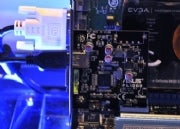Micro Usb 5 Pin Vs 11 Pin
Micro Usb 5 Pin Vs 11 Pin

It seems as if we've been writing virtually USB 3.0 forever, but it has really been just about two years since Intel and other parties formed a promotional group for USB 3.0 in 2007. The spec was completed in November 2008, at which time the standard'due south backers said that a overabundance of devices would hit the market late this year. Well, that argument turned out to be almost correct: Devices are coming very soon, merely the glut won't exist until next year.

SuperSpeed USB (as USB 3.0 is called) supports a maximum data charge per unit of 4.8 gigabits per 2d, compared with 480 megabits per 2nd for Hello-Speed USB (USB 2.0). That amounts to a theoretical maximum of 600 megabytes per second–it's way faster than near difficult drives, and it's coming but in time for a wave of newer and speedier solid-state drives. To requite you an thought of how fast that is, information technology'southward the equivalent of moving almost one total CD'due south worth of information in 1 second.
USB 3.0 achieves those speeds with a new plug and cable format, merely it's all backward-compatible with USB two.0 and USB ane.1. Plug in your old device, and information technology will still work (at the older speed). Plug a USB 3.0 device into a USB 2.0 port, and it volition run at the slower speed.
What'south more, the USB 3.0 protocol is now total-duplex: Devices can ship and remember data simultaneously, which wasn't truthful with USB one.1 and 2.0. Lower operating voltages and the elimination of broadcasting and polling (methods that the previous USB standards used to communicate with all attached devices) should brand USB hosts draw less ability, but a college maximum carried voltage should assistance you charge your portable devices more apace.

It sounds great–and recently it seemed poised to make its debut. Asus was scheduled to ship the loftier-end P6X58 Premium motherboard with USB 3.0 ports provided past NEC's host controller (for the uninitiated, the traffic cop for external devices), just the company announced a slight filibuster. NEC'due south host controller just obtained the kickoff USB three.0 certification of any host on September 21, nevertheless, and so that Asus board should run across the light of day soon.
A few more than motherboards equipped with USB 3.0, all using NEC's host controller, should crop up afterward this yr, and Fujitsu is close to releasing a laptop with USB 3.0 ports. USB iii.0 ports will become far more common on laptops and desktop PCs throughout 2010.
All the ports in the world are useless without compatible devices, of course. We saw a demo at IDF 2009 of an external solid-state drive with a USB iii.0 connection past LucidPath that achieved a transfer rate of over 240MB per second (and if you've always used an external USB difficult drive, y'all'll know just how much faster that transfer rate is). These sorts of mass storage devices should be the first to hit the market, starting early in 2010.

Expect video cameras to start using USB 3.0, likewise. Point Greyness has demonstrated a loftier-def Webcam that uses USB 3.0, though it isn't even so a aircraft product. Unlike current USB Webcams, this USB 3.0 model does not accept to compress the video feed before sending it to the PC. SuperSpeed USB is fast enough to transmit the raw, uncompressed HD video to the PC for capture or compression, which can greatly improve the video quality and make loftier-def Webcams cheaper, likewise. Devices like these will get in a piffling afterward in 2010, but you should see all sorts of products carrying the SuperSpeed USB characterization on store shelves by the end of 2010.
None of this means that USB 2.0 is going anywhere, of form; it will proceed to be the more affordable pick until USB 3.0 controllers come congenital into the I/O host controllers of motherboards (the NEC USB iii.0 host controller mentioned above is a separate flake on the motherboard, and is not part of the motherboard'south principal host controller). And USB 2.0 is notwithstanding suitable for input devices–mice and keyboards don't require all of the available bandwidth that SuperSpeed USB promises.
Nonetheless, it's good to know that the college-speed, lower-power, faster-charging cabled future is almost upon us. Mayhap your future 128GB iPod, Zune, or smartphone won't have 2 hours to fill upward with music.
Micro Usb 5 Pin Vs 11 Pin
Posted by: bantonfisir1981.blogspot.com

0 Response to "Micro Usb 5 Pin Vs 11 Pin"
Post a Comment